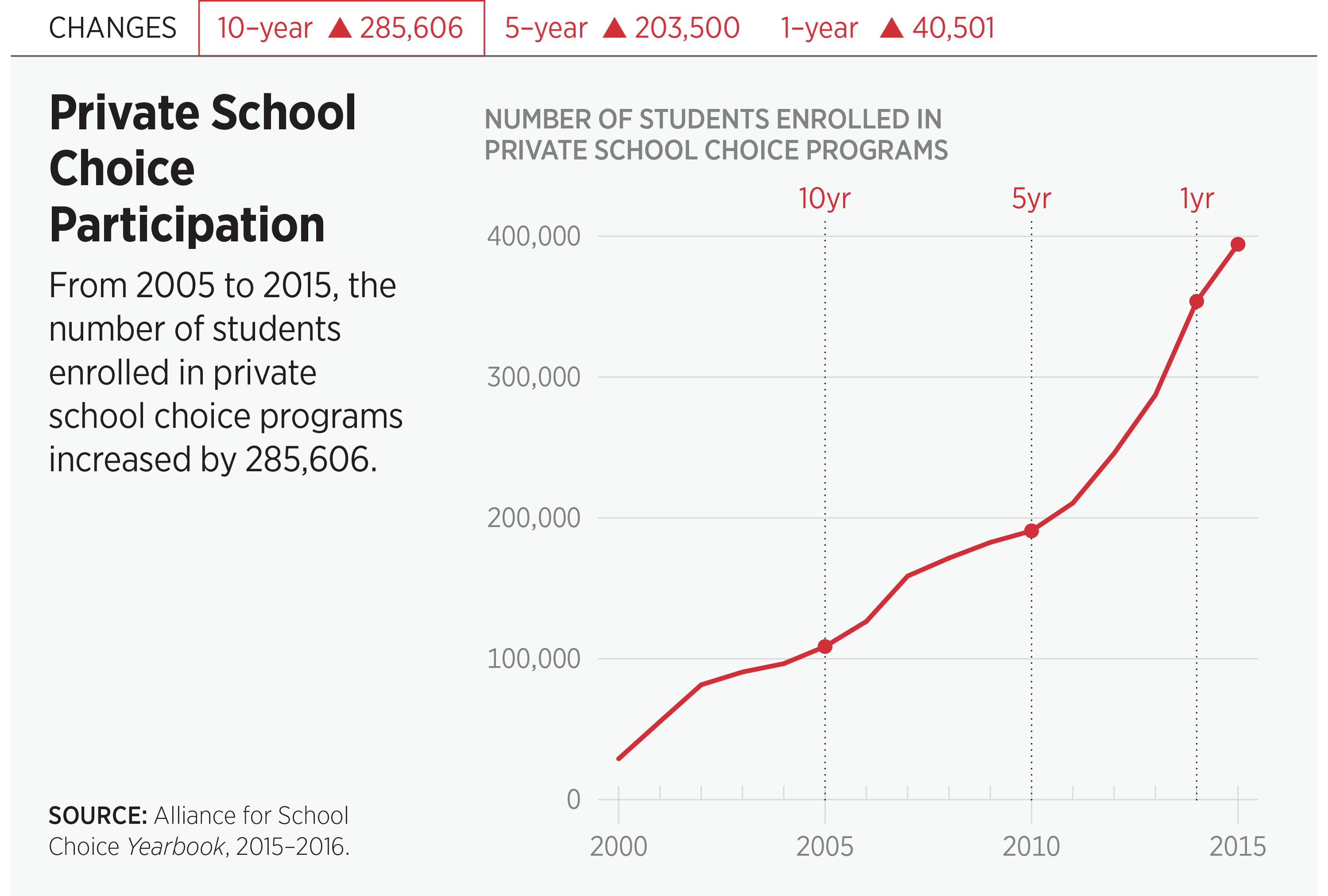The interaction of two trend lines suggests that support for school choice will only grow in years to come. The first is our increasingly ethnically and racially diverse population. In the span of three decades, the share of the non-white population has grown exponentially, and according to demographers, the U.S. is well on its way to becoming a minority-majority population by mid-century.1
The second is that support for school choice among minority Americans is growing.2 This is significant because according to the Pew Research Center, nearly one-quarter of all students enrolled in our public schools are Latino.3 In some of our biggest public school districts, minority Americans make up the majority of the school body’s population.
Equally important is that much of the growth we are seeing is a result not of increased immigration to the U.S., but of higher birth rates among Latinos. The Pew Research Center has observed that most of the growth in the Latino population in recent years was due to births, not immigration.4 This explains why one-quarter of all kindergarten students are Latino.5
Unfortunately, there is ample evidence to suggest that many of these same students are not well served by our public school system. Ineffective educators, violence, and a lack of high academic standards are contributing to the increased demand for greater choice among minority families.
According to a recent poll conducted by the left-leaning Beck Research polling company, three-quarters of all Latinos polled support school choice.6 The same poll found that support for school choice among African Americans is also high at around 72 percent.7 Even though school choice is typically seen as a Republican issue, the same poll also found that a slight majority of Democrats (55 percent) support school choice, suggesting that educational freedom is quickly becoming a bipartisan issue.
Besides polling, there is other evidence that minority families are favorably disposed toward school choice. One way we can see this is in the growing number of minority students enrolling in public charter schools and private school choice programs. According to the National Alliance for Public Charter Schools, “Hispanic students comprise roughly 30 percent of charter school enrollment across the country, compared to 25 percent representation in traditional public schools.”8
Moreover, a number of empirical studies suggest that Hispanic students are better served in public charter schools than in traditional public schools.9 For instance, one study found that charter schools serving a sizable Hispanic student body and English learners (ELs) are better positioned to service these communities because they are allowed to provide extended learning time while accelerating the pace at which EL students are able to engage with grade-level content.10 Other studies are also finding that charter schools have a higher rate of success in sending Hispanic students to higher education institutions.11
Not surprisingly, most minority and Latino families polled say that they are satisfied with their children’s new school setting, yet opponents of school choice persist. Powerful interest groups like the National Education Association and the American Federation of Teachers are stepping up their efforts to curtail, slow, and ultimately defeat increased school choice—even if it means preventing low-income minority students from accessing high-quality schools.
The key for supporters of school choice is whether minority families will harness their support for educational freedom to shaping education public policy and calling on lawmakers to increase educational options. On this, the jury is out, but if minority families continue to grow and express support for educational freedom, the future looks bright for the broader school choice movement.
Israel Ortega is a freelance reporter who contributes to a number of publications including Forbes, the Washington Examiner, and The 74.
ENDNOTES:
1. Jeffrey S. Passel and D’Vera Cohn, “U.S. Population Projections: 2005–2050,” Pew Research Center, Pew Hispanic Center, February 11, 2008, http://www.pewsocialtrends.org/2008/02/11/us-population-projections-2005-2050/ (accessed April 27, 2017).
2. Beck Research LLC, “Re: School Choice Survey Research Results,” Memorandum to the American Federation for Children, January 10, 2017, http://www.federationforchildren.org/wp-content/uploads/2017/01/AFC-Beck-National-Survey-Results-1-10-17.pdf (accessed April 17, 2017).
3. Richard Fry and Mark Hugo Lopez, “Hispanic Public School Enrollments,” Chapter 2 in “Hispanic Student Enrollments Reach New Highs in 2011,” Pew Research Center, Pew Hispanic Center, August 20, 2012, http://www.pewhispanic.org/2012/08/20/ii-hispanic-public-school-enrollments/ (accessed April 27, 2017).
4. Jens Manuel Krogstad, “A View of the Future Through Kindergarten Demographics,” Pew Research Center Fact Tank, July 8, 2014, http://www.pewresearch.org/fact-tank/2014/07/08/a-view-of-the-future-through-kindergarten-demographics/ (accessed April 27, 2017).
5. Ibid.
6. American Federation for Children, “Poll: Public Support for School Choice Remains Strong, Supportive of Federal Movement to Increase School Choice,” January 12, 2017, https://www.federationforchildren.org/poll-public-support-school-choice-remains-strong-supportive-federal-movement-increase-school-choice/ (accessed April 17, 2017).
7. Ibid.
8. National Alliance for Public Charter Schools, “Charter Public Schools Serving Hispanic Communities,” September 2016, http://www.publiccharters.org/wp-content/uploads/2016/09/CSHIS_Report.pdf (accessed April 27, 2017).
9. Stanford University, Center for Research on Education Outcomes, National Charter School Study 2013, https://edubirdie.com/wp-content/uploads/2023/10/National-Charter-School-Study.pdf (accessed April 27, 2017, link updated October 4, 2023).
10. National Alliance for Public Charter Schools, “Charter Public Schools Serving Hispanic Communities.”
11. Ibid., p. 2.

